Lesson: Shake It Up with Seismographs
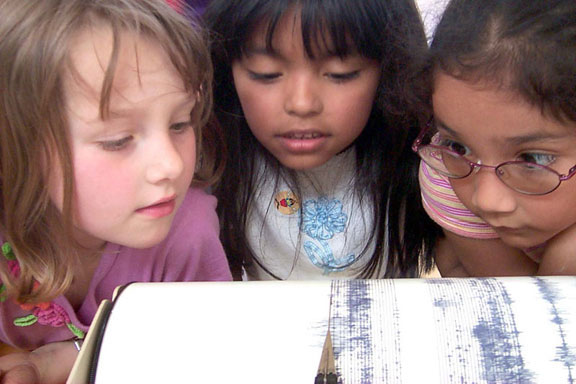
From TryEngineering, developed by the IEEE
Summary
Students in grades 3 – 12 explore how the development of seismographs has helped save lives worldwide by working in teams to design their own seismograph from everyday items, test its ability to record a simulated classroom earthquake, evaluate their results, and report to the class.
Grade Level: 3 – 12
Time: One to two 45-minute sessions
Objectives
- Learn about seismograph technology.
- Learn about engineering design.
- Learn about teamwork and problem solving.
Learning outcomes 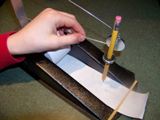
As a result of this activity, students should develop an understanding of:
- seismographs
- interaction of technology and environmental issues
- engineering design
- teamwork
Standards
National Science Education Standards
Grades K-4
CONTENT STANDARD A: Science as Inquiry
As a result of activities, all students should develop:
- Abilities necessary to do scientific inquiry (grades K-4)
- Understanding about scientific inquiry (grades k-4)
- Abilities necessary to do scientific inquiry (grades 9 -12)
- Understandings about scientific inquiry (grades 9 -12)
CONTENT STANDARD B: Physical Science
As a result of the activities, all students should develop an understanding of:
- Position and motion of objects. (grades K-4)
- Motion and forces (grades 5 -12)
- Transfer of Energy (Grades 5 – 8 )
- Interactions of energy and matter (grades 9 -12)
CONTENT STANDARD D: Earth and Space Science
As a result of their activities, all students should develop an understanding of:
- Changes in Earth and sky. (grades k-4)
- Energy in the Earth system (grades 9 -12)
CONTENT STANDARD E: Science and Technology
As a result of activities, all students should develop
- Abilities of technological design (grades K-12)
- Understanding about science and technology (grades K-12)
- Abilities of technological design (grades 5 -8 )
- Understandings about science and technology (grades 5 – 8 )
CONTENT STANDARD F: Science in Personal and Social Perspectives
As a result of activities, all students should develop understanding of
- Changes in environments (grades K-4)
- Science and technology in local challenges (grades K-4)
- Populations, resources, and environments (grades 5 – 8 )
- Natural hazards (grades 5 -8 )
- Science and technology in society (grades 5 – 8 )
- Natural and human-induced hazards (grades 9 -12)
- Science and technology in local, national, and global challenges (grades 9-12)
CONTENT STANDARD G: History and Nature of Science
As a result of activities, all students should develop understanding of
- Science as a human endeavor (grades K-4)
- History of science (grades 5 – 8 )
- Historical perspectives (grades 9 -12)
Standards for Technological Literacy
The Nature of Technology
- Standard 3: Students will develop an understanding of the relationships among technologies and the connections between technology and other fields of study.
Technology and Society
- Standard 5: Students will develop an understanding of the effects of technology
- on the environment.
- Standard 6: Students will develop an understanding of the role of society in the development and use of technology.
- Standard 7: Students will develop an understanding of the influence of technology on history.
Design
- Standard 8: Students will develop an understanding of the attributes of design.
- Standard 9: Students will develop an understanding of engineering design.
- Standard 10: Students will develop an understanding of the role of troubleshooting, research and development, invention and innovation, and experimentation in problem solving.
Abilities for a Technological World
- Standard 11: Students will develop abilities to apply the design process.
The Designed World
- Standard 17: Students will develop an understanding of and be able to select and use information and communication technologies
Motivation 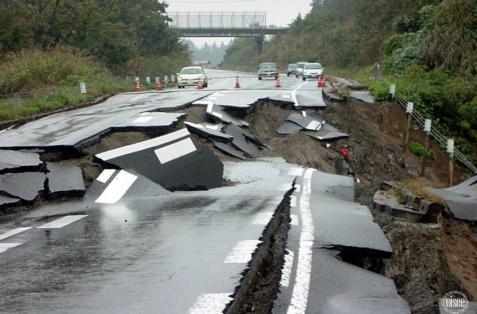
The U.S. Geological Survey estimates that millions of earthquakes occur each year. Most go unnoticed because they hit in remote rural areas. But some cause massive destruction. Two years after a January, 2010 leveled Haiti, more than half a million people are still living under tarps or in tents. Tsunamis created by strong temblors beneath the sea wiped out coastal villages in Indonesia and triggered a nuclear-power catastrophe in Japan. Closer to home, a rare mid-Atlantic earthquake crumbled portions of the Washington Monument, which remains closed to visitors.
This lesson explores seismographs and how technology can help notify society of impending dangers and help save lives.
Materials 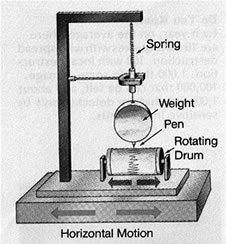
For each team of students:
- Student worksheet & reflection sheet (pages 7 – 9 of guide.)
- String
- Wire
- Paper
- Pencil
- Marker pen
- Paper clips
- Glue
- Cardboard
- Poster board
- Foil
- Rubber bands
- Tape
- Pan or tray
- Clay
For teacher:
- Rubber ball (or tennis ball) to drop from height to simulate earthquake
- Ladder or stool from which to drop ball to simulate earthquake
- Strings cut to .5 meter, 1 meter, and 1.5 meters in length for measuring distance from which to drop the ball
Procedure
1. Show students the student reference sheet (page 4 -6 of the lesson guide) with the history of seismographs and an explanation of such earthquake terms as Richter Scale. These may be read in class or provided as reading material for the prior night’s homework.
2. Provide student teams with a set of materials and ask them to build their own seismograph that will allow them to record the intensity of a simulated classroom earthquake. The best design will record the smallest disturbance.
3. Student teams present their designs to the class and explain how they expect the recording to work.
4. Test each team’s seismograph by placing it on top of a small table. Have teacher simulate a disturbance by dropping a small rubber ball on the table from three different heights (.5 meter, 1 meter, and 1.5 meters). To ensure a consistent and fair test, stand on a secure ladder and measure with lengths of string the point from which the ball
will drop. (Note: you may wish to consider using different size balls as well, such as a tennis ball.)
5. Students record and review their results and the results of other teams, and present their reflections to the class.
Extensions
- Have students write an essay or a paragraph exploring why civil engineers might need to evaluate the seismic activity of a particular building site.
- Have students write an essay or a paragraph on how existing seismologic technology might have reduced death rates from the 1960 earthquake in Chile.
- Help students understand earthquakes and stresses on rocks by tearing apart a bar of soap. (TeachEngineering.org activity.)
Resources 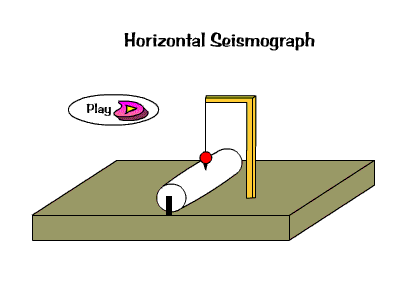
- USGS Earthquakes for Kids
- USGS National Earthquake Information Center includes current worldwide list of earthquakes.
- USGS Earthquakes in the news. List of real-time earthquakes and the global top 10.
- USGS National Registry of Seismic Stations.
- NASA’s Jet Propulsion Lab earthquake measurement and detection education page includes animations showing how seismographs work.
- Plate tectonics documentary. [YouTube 07:42]
- Seismic waves, short animation [YouTube 1:40]
Filed under: Grades 6-8, Grades 9-12, Grades K-5, Lesson Plans
Tags: earthquake, Earthquake materials, Seismology








